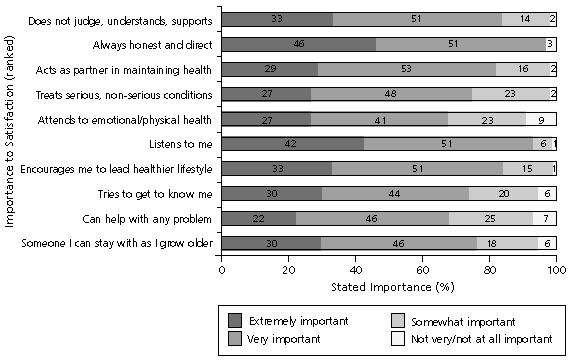
Am Fam Physician. 2004;69(10):2310
The public wants and is satisfied by care provided within a patient-physician relationship based on understanding, honesty, and trust. If the U.S. health care system is ever to become patient-centered, it must be designed to support these values and sustain, rather than fracture, the relationships people have with their primary physician.
Recognizing fundamental flaws in the U.S. health care system and the potential of an integrative, generalist approach to help remedy them, national family medicine organizations initiated the Future of Family Medicine (FFM) project to develop a strategy to transform family medicine to better meet the needs of patients. As part of FFM, the global research company Roper ASW surveyed 1,031 people between June 14 and July 1, 2002. The sample design mirrored the general population of the United States with regard to race, ethnicity, gender, age, and location. Respondents were asked to grade the importance of 40 attributes “when it comes to your primary doctor.” Overall, people want their primary doctor to meet the following five basic criteria: to be in their insurance plan, to be in a location that is convenient, to be able to schedule an appointment within a reasonable period of time, to have good communication skills, and to have a reasonable amount of experience in practice. Beyond the basic criteria, people value the relationship with their physician above all else, including service. People value a physician who listens to them, who takes the time to explain things to them, and who is able to effectively integrate their care.1 The attributes identified as most important in driving patient satisfaction are rank ordered by their importance in the accompanying figure.
These national results are consistent with contemporary state studies examining patient preferences and satisfaction.2,3 Also, the physician attributes influencing patient satisfaction fit neatly within the definition of primary care published by the Institute of Medicine in 1996 and correlate with drivers of family physician satisfaction.4 The public and family physicians want primary care within a continuous patient-physician relationship grounded on understanding, honesty, and trust. The current health care system fractures these relationships, leaving patients and family physicians dissatisfied. Whatever course is pursued in the development of an equitable, accessible system for all Americans, it must recognize that people want the type of care that family physicians want to provide.
